2021-01-21 - Nº 299
Editorial
Esta é a Newsletter Nº 299 que se apresenta com o mesmo formato que as anteriores. Se gostar da Newsletter partilhe-a!
Todas as Newsletters encontram-se indexadas no link.
Esta Newsletter tem os seguintes tópicos:
Faz hoje anos que nascia, em 1743, o inventor americano John Fitch. Ele foi pioneiro do transporte de barcos a vapor que produziu barcos a vapor utilizáveis antes de Robert Fulton. Fitch encontrou apoio privado, então rapidamente construiu um motor com recursos dos motores a vapor de Watt e Newcomen. Ele evoluiu de erro em erro até fazer o primeiro barco a vapor. Era uma máquina estranha - movida por um suporte de remos de canoa indiana. Ainda assim, no verão de 1790, Fitch usou-o numa linha de passageiros de sucesso entre Filadélfia e Trenton. Em 26 de Agosto de 1791, John Fitch recebeu uma patente dos EUA para o barco a vapor.
Faz também hoje anos que nascia, em 1868, o químico alemão Felix Hoffmann. Ele descobriu a aspirina, enquanto pesquisador da Bayer & Co. No início, ele considerou a farmácia, mas voltou-se para a química. Ele obteve um Ph.D. e de seguida, ingressou na empresa de Friedrich Bayer em 1894. Ele estava interessado em encontrar um analgésico melhor para o reumatismo crónico do seu pai, para substituir o uso de ácido salicílico, que tinha um sabor amargo e causava dores de estômago. A 10 de Agosto de 1897, ele formou um derivado, ácido acetilsalicílico (C9H8O4), acetilando ácido salicílico com ácido acético. Os testes da empresa mostraram que era um medicamento seguro e eficaz para alívio da dor, redução da febre e como anti-inflamatório. Foi comercializado a partir de 1899.
Faz igualmente hoje anos que nascia, em 1874, o matemático francês René-Louis Baire. Ele dedicou-se ao estudo de números irracionais e cujo conceito de dividir a noção de continuidade em semi-continuidade superior e inferior influenciou muito a Escola Francesa de Matemática. A sua tese de doutorado levou à solução do problema da propriedade característica de funções limitadas de funções contínuas e ajudou a estabelecer a teoria das funções de variáveis reais.
Por fim, faz hoje anos que nascia, em 1912, o bioquímico alemão-americano Konrad Emil Bloch. Ele partilhou o Prémio Nobel de Fisiologia ou Medicina de 1964 com Feodor Lynen pelas suas descobertas a respeito da síntese natural de colesterol e de ácidos gordos. Bloch identificou o processo químico pelo qual o corpo transforma o ácido acético em colesterol. Ele descobriu o ponto em que é possível regular a quantidade de colesterol que o corpo produz. Ele descobriu que altos níveis de colesterol na corrente sanguínea causam depósitos de gordura nas paredes internas das artérias, o que pode levar à redução do fluxo sanguíneo e aumentar as hipóteses de coagulação do sangue e ataque cardíaco.
Faz hoje 45 anos que foi introduzido o voo supersónico comercial. Foram feitos nessa data dois voos, um a partir do aeroporto Heathrow de Londres com destino ao Bahrein, no Golfo Pérsico. O outro voo a partir do Aeroporto de Orly, em Paris, para o Rio de Janeiro, Brasil, via Senegal, na África Ocidental. O Concorde tinha motores duas vezes mais potentes que os jactos normais, a sua velocidade de cruzeiro de 2.172 Km/h era o dobro da velocidade do som (Mach 2,04) e reduziu pela metade o tempo das viagens aéreas, a uma altitude de cruzeiro de 60.000 pés (17.700 m). O seu enorme custo de produção foi repartido entre os governos da Grã-Bretanha e da França. Os desafios técnicos incluíram a construção da estrutura da aeronave para suportar a pressão imensa de ondas de choque e suportar altas temperaturas do atrito do ar. O Concorde tinha uma configuração de asa delta e foi o primeiro avião civil a ser equipado com um sistema de controle de voo analógico fly-by-wire. Os voos transatlânticos regulares da Europa começaram para Washington D.C. em 24 de maio de 1976 e operam para Nova York em 22 de Novembro de 1977. O último voo comercial do Concorde foi a 24 de Outubro de 2003.
E Nesta semana que passou a Virgin Orbit conseguiu, com um voo de teste que não só atingiu seus objectivos de alcançar o espaço e a órbita, mas também de entregar cargas úteis a bordo para a NASA, marcando também sua primeira missão comercial. O lançamento foi um sucesso em todos os aspectos possíveis, o que coloca a Virgin Orbit no caminho certo para se tornar uma opção para lançamento no espaço de pequenas cargas para clientes comerciais e de defesa. Lançado a partir de um Boeing 747-400 modificado com o nome de Cosmic Girl, lançou com sucesso o foguetão LauncherOne que atingiu o espaço. Na conclusão do voo de teste, foram lançados 10 CubeSats.
Também nesta semana que passou a Raspberry Pi anunciou um novo membro da família. Trata-se do Raspberry Pi Pico - uma pequena placa com dimensões parecidas com as de um Arduino Nano. No entanto trata-se de uma placa completamente diferente, ao contrario dos outros Raspberry Pi, esta não tem como objectivo a execução de um sistema operativo como o Linux mas sim, funcionar como um Arduino ou um ESP32. Foi desenhado um processador designado por RP2040 que é um Dual-core ARM Cortex M0+, com velocidade de relógio até 133 Mhz e 264KB de SRAM. A placa tem 2MB de Flash e disponibiliza 30 GPIO multi-função dos quais 4 podem ser usados como entradas analógicas, 2 interfaces SPI, 2 interfaces I2C, 2 UARTS, 16 canais de PWM e 8 IO programáveis, 1 USB 1.1 para carga e comunicação. Consegue funcionar com cerca de 100 mA @ 5 V e tem modos de suspensão com retenção de memória total abaixo de 1 mA. O custo também é uma surpresa agradável e fica-se abaixo dos 5 USD ou 5€.
Na Newsletter desta semana apresentamos diversas noticias, artigos científicos assim como projetos de maker. É apresentada a revista Hackspace Magazine nº 39 e o livro "Get Started with MicroPython on Raspberry Pi Pico".
 João Alves ([email protected])
João Alves ([email protected])
O conteúdo da Newsletter encontra-se sob a licença  Creative Commons Attribution-NonCommercial-ShareAlike 4.0 International License.
Creative Commons Attribution-NonCommercial-ShareAlike 4.0 International License.
Novidades da Semana

Virgin Orbit Aces Second Launch Demo and Deploys NASA Payloads
"Virgin Orbit, the California-based satellite launch company, confirmed that its LauncherOne rocket reached space during the company’s second launch demonstration today, successfully deploying 10 payloads for NASA’s Launch Services Program (LSP). Virgin Orbit’s novel launch system uses a technique called air launch, in which a rocket is launched from under the wing of a jet aircraft, rather than from a traditional launch pad on the ground. In addition to improving the payload capacity of the rocket, this technique allows the LauncherOne system to be the world’s most flexible and responsive launch service — flying on short notice and from a wide variety of locations to access any orbit. For today’s picture-perfect mission, Virgin Orbit’s carrier aircraft, a customized 747-400 dubbed Cosmic Girl, took off from Mojave Air and Space Port at approximately 10:50 A.M. and flew out to a launch site over the Pacific Ocean, about 50 miles south of the Channel Islands. After a smooth release from the aircraft, the two-stage rocket ignited and powered itself to orbit. At the conclusion of the flight, the LauncherOne rocket deployed 10 CubeSats into the team’s precise target orbit, marking a major step forward for Virgin Orbit in its quest to bust down the barriers preventing affordable and responsive access to space." [...]
Meet Raspberry Silicon: Raspberry Pi Pico now on sale at $4
"Today, we’re launching our first microcontroller-class product: Raspberry Pi Pico. Priced at just $4, it is built on RP2040, a brand-new chip developed right here at Raspberry Pi. Whether you’re looking for a standalone board for deep-embedded development or a companion to your Raspberry Pi computer, or you’re taking your first steps with a microcontroller, this is the board for you. You can buy your Raspberry Pi Pico today online from one of our Approved Resellers. Or head to your local newsagent, where every copy of this month’s HackSpace magazine comes with a free Pico, as well as plenty of guides and tutorials to help you get started with it. If coronavirus restrictions mean that you can’t get to your newsagent right now, you can grab a subscription and get Pico delivered to your door." [...]
Outras Notícias

A Trusted Companion: AI Software Keeps Drivers Safe and Focused on the Road Ahead
"NVIDIA DRIVE IX cabin perception software provides advanced driver monitoring, personalization, in-cabin situational understanding and intuitive AI assistants. Even with advanced driver assistance systems automating more driving functions, human drivers must maintain their attention at the wheel and build trust in the AI system. Traditional driver monitoring systems typically don’t understand subtle cues such as a driver’s cognitive state, behavior or other activity that indicates whether they’re ready to take over the driving controls. NVIDIA DRIVE IX is an open, scalable cockpit software platform that provides AI functions to enable a full range of in-cabin experiences, including intelligent visualization with augmented reality and virtual reality, conversational AI and interior sensing. Driver perception is a key aspect of the platform that enables the AV system to ensure a driver is alert and paying attention to the road. It also enables the AI system to perform cockpit functions that are more intuitive and intelligent." [...]

Integrated Impedance-Matching and Protection IC from STMicroelectronics Simplifies Portable GNSS Receivers
"STMicroelectronics’ BPF8089-01SC6 RF front-end for Global Navigation Satellite System (GNSS) receivers simplifies design and saves real-estate by integrating the impedance-matching and electrostatic-discharge (ESD) protection circuitry typically implemented using discrete components. The BPF8089-01SC6 provides a 50Ω matched interface between the receiver’s antenna and low-noise amplifier (LNA), and is ready to plug-and-play with ST’s STA8089 and STA8090 LNAs. This compact, integrated device typically replaces a matching network containing up to five capacitors, resistors, and inductors, as well as two discrete protection devices, resulting in a much smaller footprint. Designers can also leverage PCB-track specifications provided in the device datasheet to ease design challenges and ensure optimal performance. The ESD protection provided complies with IEC 61000-4-2 (C = 150pF, R = 330Ω) and exceeds level 4: 8kV for contact discharge and 15kV for air discharge. The device also withstands 2kV pulse voltage in accordance with MIL STD 883C (C = 100pF, R = 1.5kΩ)." [...]

NXP Unlocks the 6GHz Spectrum with a Wi-Fi 6E Tri-Band Chipset for Access Devices
"NXP Semiconductors N.V. (NASDAQ: NXPI) today announced it is laying the foundation for a new era of Wi-Fi 6 devices that can operate in the 6GHz band with its new CW641 Wi-Fi 6E Tri-Band system-on-chip (SoC). With increasing congestion in the legacy 2.4GHz and 5GHz bands, the US FCC has approved 1.2GHz of unlicensed spectrum for the 6GHz band along with other regions around the world, which will transform the Wi-Fi landscape. NXP is introducing a Wi-Fi 6E device that will make use of this 6GHz band and extend Wi-Fi capacity by bringing higher throughput, increased capacity, reliability, and improved latency. Designed for access points and service provider gateways, the CW641 unlocks increased speeds of over 4Gbps and multi-user performance in the new 6GHz band, providing greater capacity and lower latency, which dramatically improves the Wi-Fi user experience. Adding 6GHz capabilities to gateway platforms gives service providers options to efficiently partition available bandwidth across devices to ensure optimum user experience for a wide range of applications. Mission critical, high bandwidth, low latency applications like mesh back haul and cloud gaming are ideal for migration to 6GHz, freeing up the 5GHz and 2.4GHz bands for other lower bandwidth applications." [...]

Toshiba Starts Shipping World's Smallest Bluetooth® Low Energy Module
"SASP™ technology realizes a module small enough to build into a button, bringing added convenience to health management and exercise analysis with wearable devices Toshiba Corporation (TOKYO: 6502) has developed the world's smallest (*1) Bluetooth® Low Energy module, with proprietary SASP™ technology. Toshiba will start shipping samples of the module on January 15. Bluetooth® delivers short distance wireless connectivity between products. It has made crucial contributions to today’s widespread popularity of wearable devices, including smart watches and devices worn on and in the ear, largely thanks to modules that meet the Bluetooth® Low Energy standard for smaller devices with lower power consumption. Toshiba has now widened these horizons even further with the development of a Bluetooth® Low Energy module that is ultra-small at only 4mm x 10mm, and almost undetectable when worn at about 0.09g in weight. The module is expected to bring wearable devices into previously impossible areas, including sportswear, buttons, and even ordinary clothes." [...]

Renesas Launches New General-Purpose 64-Bit RZ/G2L Group of MPUs with Latest Arm Cortex-A55 for Improved AI Processing
"Renesas Electronics Corporation (TSE:6723), a premier supplier of advanced semiconductor solutions, today announced the expansion of its RZ/G2 general-purpose 64-bit microprocessors (MPUs), delivering improved AI processing for a wide range of applications. The expanded product lineup includes three new entry-level MPU models built around the latest Arm® Cortex®-A55 core: The RZ/G2L, RZ/G2LC, and RZ/G2UL. Together with the existing mid- to high-end RZ/G2E, RZ/G2N, RZ/G2M, and RZ/G2H MPUs, the total of seven RZ/G2 MPUs provide scalability from entry-level to high-end design. The new RZ/G2L MPUs are built around the Cortex-A55 CPU core, which delivers approximately 20 percent improved processing performance compared with the previous Cortex-A53 core and provides approximately six times faster in essential processing for AI applications. In addition, the new MPUs integrate camera input interfaces, a 3D graphics engine, and a video codec, providing cost-efficient support for sophisticated functionality for human-machine interface (HMI) applications, such as multimedia processing, GUI rendering, and AI image processing. The MPUs also feature the Cortex-M33 core, which makes it possible to perform real-time processing for tasks such as sensor data collection without the need for external microcontrollers (MCUs), reducing the overall system cost." [...]
ON Semiconductor Enhances IoT Asset Management with Angle of Arrival (AoA) Location Technology
"ON Semiconductor (Nasdaq: ON), driving energy efficient innovations, today announced the availability of the Intelligent Locating System™ for the RSL10, the industry’s lowest power Flash-based Bluetooth® Low Energy radio System on Chip (SoC). Provided in a user-friendly CMSIS-Pack format, the solution allows manufacturers to design ultra-low-power indoor asset tracking applications with Direction Finding features and advanced Angle of Arrival (AoA) technology. The Quuppa Intelligent Locating System is a powerful technology platform for location-based services and applications. Its unique Direction Finding methodology and positioning algorithms enable real-time tracking of tags and devices, with centimeter-level accuracy even in challenging environments. Quuppa technology allows positioning updates to be sent up to 50 times per second, providing a reliable and versatile Real-Time Locating System (RTLS) solution for all industries. The RSL10 Quuppa AoA RTLS Tag CMSIS Pack is available as part of a comprehensive asset management development ecosystem from ON Semiconductor and technology partners." [...]
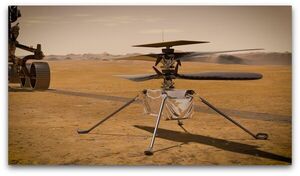
6 Things to Know About NASA’s Mars Helicopter on Its Way to Mars
"Ingenuity, a technology experiment, is preparing to attempt the first powered, controlled flight on the Red Planet. When NASA’s Perseverance rover lands on Mars on Feb. 18, 2021, it will be carrying a small but mighty passenger: Ingenuity, the Mars Helicopter. The helicopter, which weighs about 4 pounds (1.8 kilograms) on Earth and has a fuselage about the size of a tissue box, started out six years ago as an implausible prospect. Engineers at NASA’s Jet Propulsion Laboratory in Southern California knew it was theoretically possible to fly in Mars’ thin atmosphere, but no one was sure whether they could build a vehicle powerful enough to fly, communicate, and survive autonomously with the extreme restrictions on its mass. Then the team had to prove in Earthbound tests that it could fly in a Mars-like environment. Now that they’ve checked off those objectives, the team is preparing to test Ingenuity in the actual environment of Mars." [...]

NASA Conducts Test of SLS Rocket Core Stage for Artemis I Moon Mission
"NASA conducted a hot fire Saturday of the core stage for the agency’s Space Launch System (SLS) rocket that will launch the Artemis I mission to the Moon. The hot fire is the final test of the Green Run series. The test plan called for the rocket’s four RS-25 engines to fire for a little more than eight minutes – the same amount of time it will take to send the rocket to space following launch. The team successfully completed the countdown and ignited the engines, but the engines shut down a little more than one minute into the hot fire. Teams are assessing the data to determine what caused the early shutdown, and will determine a path forward. For the test, the 212-foot core stage generated 1.6 million pounds of thrust, while anchored in the B-2 Test Stand at NASA’s Stennis Space Center near Bay St. Louis, Mississippi." [...]

CircuitPython 6.1.0 released!
"This is CircuitPython 6.1.0, the latest minor revision of CircuitPython, and is a new stable release. See Port status below for details on port stability, and Known Issues for known problems. If you find any issues with this release, please file an issue. Download from circuitpython.org Downloads are available from circuitpython.org. The site makes it easy to select the correct file and language for your board. The downloads page is here." [...]

Fast and reliable internet connectivity brings new hope to rural villages
"Just a few years ago the people of Churni probably would have had a better chance of spotting an endangered tiger than enjoying a steady internet signal. Doing simple everyday tasks online in this out-of-the-way community in the western India state of Maharashtra was hit-or-miss at best. But things are looking up in this remote tribal village thanks to AirJaldi. The internet service provider is helping connect hundreds of thousands of people in rural and semi-urban pockets across India as part of Microsoft’s Airband Initiative, which aims to extend internet access to millions of people around the world. A Common Services Center offering access to essential government e-services in Churni used to struggle with the village’s flaky internet connection. It was so unreliable many people simply chose to travel 65 kilometers (40 miles) to another town with better connectivity to do their online chores like filing legal documents or accessing government services." [...]

SpaceX’s 1st Starlink launch of 2021 went off without a hitch Wednesday
"SpaceX launched 60 more of its Starlink satellites on January 20, 2021. SpaceX ultimately intends to launch tens of thousands of these satellites, to provide global internet access. Here’s why astronomers are concerned. SpaceX launched another 60 Starlink internet satellites into orbit on Wednesday (January 20, 2021). The SpaceX workhorse rocket – a Falcon 9 rocket – lifted off as scheduled from Pad 39A at NASA’s Kennedy Space Center at 8:02 a.m. EDT (12:02 UTC). The launch had been delayed for two days due to poor weather in the recovery zone and pre-flight checking issues." [...]
Ciência e Tecnologia
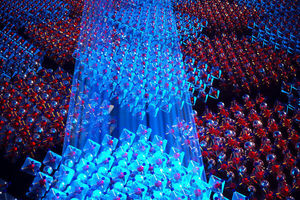
Researchers develop new one-step process for creating self-assembled metamaterials
"A team led by University of Minnesota Twin Cities researchers has discovered a groundbreaking one-step process for creating materials with unique properties, called metamaterials. Their results show the realistic possibility of designing similar self-assembled structures with the potential of creating “built-to-order” nanostructures for wide application in electronics and optical devices. The research was published and featured on the cover of Nano Letters, a peer-reviewed scientific journal published by the American Chemical Society. In general, metamaterials are materials made in the lab to provide specific physical, chemical, electrical, and optical properties otherwise impossible to find in naturally occurring materials. These materials can have unique properties which make them ideal for a variety of applications from optical filters and medical devices to aircraft soundproofing and infrastructure monitoring. Usually these nano-scale materials are painstakingly produced in a specialized clean room environment over days and weeks in a multi-step fabrication process." [...]
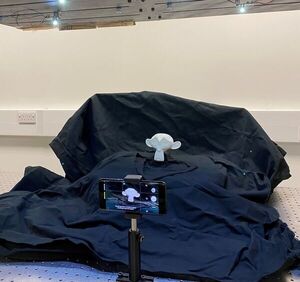
Researchers Acquire 3D Images with LED Room Lighting and a Smartphone
"As LEDs replace traditional lighting systems, they bring more smart capabilities to everyday lighting. While you might use your smartphone to dim LED lighting at home, researchers have taken this further by tapping into dynamically controlled LEDs to create a simple illumination system for 3D imaging. “Current video surveillance systems such as the ones used for public transport rely on cameras that provide only 2D information,” said Emma Le Francois, a doctoral student in the research group led by Martin Dawson, Johannes Herrnsdorf and Michael Strain at the University of Strathclyde in the UK. “Our new approach could be used to illuminate different indoor areas to allow better surveillance with 3D images, create a smart work area in a factory, or to give robots a more complete sense of their environment.” In The Optical Society (OSA) journal Optics Express, the researchers demonstrate that 3D optical imaging can be performed with a cell phone and LEDs without requiring any complex manual processes to synchronize the camera with the lighting. “Deploying a smart-illumination system in an indoor area allows any camera in the room to use the light and retrieve the 3D information from the surrounding environment,” said Le Francois. “LEDs are being explored for a variety of different applications, such as optical communication, visible light positioning and imaging." [...]
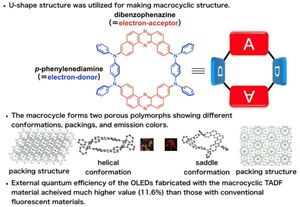
Light-up wheels: Unique organic light-emitting molecular emitters
"Researchers at Osaka University design and synthesize highly efficient carbon-based 3rd-generation OLED molecular emitters by linking the donor and acceptor modules into a ring A team including researchers from Osaka University has produced a new molecular emitter for organic light-emitting diodes (OLEDs). Using rational chemical design with U-shaped synthetic building blocks, the scientists were able to arrange the electron donors and acceptors into a large ring called a “macrocycle.” The wheel-shaped molecule could potentially be used not only in OLEDs but also in tiny, energy-efficient chemical sensors in the future. Many modern televisions and smartphones use OLEDs to display pictures and videos. These devices can efficiently convert electricity into light because they are made from carbon-based molecules containing alternating single and double chemical bonds, an arrangement called p-conjugation. This configuration allows electrons to become highly mobile because they are effectively “delocalized” over large regions of the molecules, which tend to be long linear chains. When a molecule is electronically excited by external energy and then relaxes to the original state, the excess energy can be converted directly into light." [...]
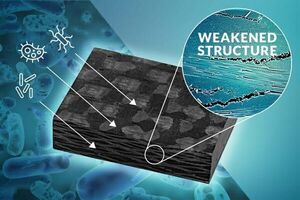
Common microbes team up to degrade polymer composites
"Polymer composites are durable, lightweight replacements for wood, metal or other materials and are used widely in everything from pipelines and utility poles to airplanes and cars. Research at the University of Wisconsin–Madison is shedding new light on how common bacteria can degrade those materials. “A lot of studies have focused on how these polymer materials would respond to environmental conditions like temperature, moisture or ultraviolet light,” says Pavana Prabhakar, a UW–Madison professor of civil and environmental engineering. “They’ve rarely been studied in the context of microbial interactions.” Prabhakar and her collaborators identified four bacterial groups that have detrimental interactions with the acrylate, esters and bisphenol commonly found in polymer composites. The group — including UW–Madison bacteriology professor Karthik Anantharaman and Adam Breister and Muhammad Imam, a research technician and a post-doctoral researcher in the Anantharaman and Prabhakar labs, respectively — published their findings recently in the journal Communications Materials. Research on microorganisms interacting with polymer composites has focused on individual types of cultivated microbes that aren’t necessarily common in natural environments, according to Prabhakar." [...]

Could We Harness Energy from Black Holes?
"A new Columbia study indicates energy can be extracted from black holes through reconnection of magnetic field lines. A remarkable prediction of Einstein's theory of general relativity—the theory that connects space, time, and gravity—is that rotating black holes have enormous amounts of energy available to be tapped. For the last 50 years, scientists have tried to come up with methods to unleash this power. Nobel physicist Roger Penrose theorized that a particle disintegration could draw energy from a black hole; Stephen Hawking proposed that black holes could release energy through quantum mechanical emission; while Roger Blandford and Roman Znajek suggested electromagnetic torque as a main agent of energy extraction. Now, in a study published in the journal Physical Review D, physicists Luca Comisso from Columbia University and Felipe Asenjo from Universidad Adolfo Ibáñez in Chile, found a new way to extract energy from black holes by breaking and rejoining magnetic field lines near the event horizon, the point from which nothing, not even light, can escape the black hole’s gravitational pull. “Black holes are commonly surrounded by a hot 'soup' of plasma particles that carry a magnetic field,” said Luca Comisso, research scientist at Columbia University and first author on the study." [...]

First Measurement Device Independent Quantum Key Distribution Experiment to Secure Communication
"PAN Jianwei and colleagues PENG Chengzhi and ZHANG Qiang, from University of Science and Technology of China of the Chinese Academy of Sciences (CAS), collaborating with WANG Xiangbin from Tsinghua University and YOU Lixing from Shanghai Institute of Microsystems of CAS, realized the measurement device independent quantum key distribution (MDI-QKD) experiment based on long-distance free space channel for the first time. The study was published online in Physics Review Letter. Due to the fact that the atmospheric turbulence in free space channel destroys the spatial mode, it is necessary to use single-mode optical fiber for spatial filtering before interferometry. The low coupling efficiency and intensity fluctuation are the two major difficulties in this experiment. The researchers in this study developed an adaptive optics system with strong turbulence resistance based on the stochastic gradient descent algorithm, which improved the total channel efficiency of dual links by about 4~10 times. The rapid fluctuation of light intensity challenges clock synchronization and optical frequency comparison methods in the traditional optical fiber system to apply." [...]
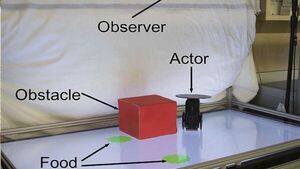
Robot Displays a Glimmer of Empathy to a Partner Robot
"Columbia engineers create a robot that learns to visually predict how its partner robot will behave, displaying a glimmer of empathy. This “Robot Theory of Mind” could help robots get along with other robots—and humans—more intuitively Like a longtime couple who can predict each other’s every move, a Columbia Engineering robot has learned to predict its partner robot’s future actions and goals based on just a few initial video frames. When two primates are cooped up together for a long time, we quickly learn to predict the near-term actions of our roommates, co-workers or family members. Our ability to anticipate the actions of others makes it easier for us to successfully live and work together. In contrast, even the most intelligent and advanced robots have remained notoriously inept at this sort of social communication. This may be about to change." [...]

Columbia Engineers First to Observe Avalanches in Nanoparticles
"Researchers develop the first nanomaterial that demonstrates "photon avalanching;" finding could lead to new applications in sensing, imaging, and light detection Researchers at Columbia Engineering report today that they have developed the first nanomaterial that demonstrates "photon avalanching,” a process that is unrivaled in its combination of extreme nonlinear optical behavior and efficiency. The realization of photon avalanching in nanoparticle form opens up a host of sought-after applications, from real-time super-resolution optical microscopy, precise temperature and environmental sensing, and infrared light detection, to optical analog-to-digital conversion and quantum sensing. “Nobody has seen avalanching behavior like this in nanomaterials before,” said James Schuck, associate professor of mechanical engineering, who led the study published today by Nature. “We studied these new nanoparticles at the single-nanoparticle level, allowing us to prove that avalanching behavior can occur in nanomaterials. This exquisite sensitivity could be incredibly transformative. For instance, imagine if we could sense changes in our chemical surroundings, like variations in or the actual presence of molecular species." [...]
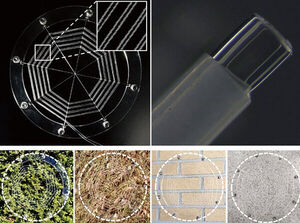
There’s a new spider in town: advancing the field of robotics with ionic spiderwebs
"A new kind of robot has been born in Professor Jeong-Yun Sun’s lab, one that takes inspiration from the way spiders spin their webs. Spiders construct webs based on a minimalist framework, which allows them to sense even the slightest vibrations produced when their prey become entangled and also allows them to clean their webs of dust and debris by slingshotting contaminants away. Professor Jeong-Yun Sun and his research team have taken the architectural expertise presented by spiders and applied it to spinning their own artificial spiderwebs which are capable of sensing, adhesion, and self-cleaning through electrostatic actuation and dirt-shirking coating. These ionic spiderwebs are part of the soft robot revolution. Soft robots are made of compliant materials and have superior flexibility and therefore better ability to carry out unpredictable or irregular tasks compared to conventional robots. Broader use of soft robots was heretofore limited by the inability to harmoniously integrate the various elements of a soft robot into a single unit but through biomimicry, specifically by mimicking the spider and its spiderweb, this problem may finally have been solved." [...]
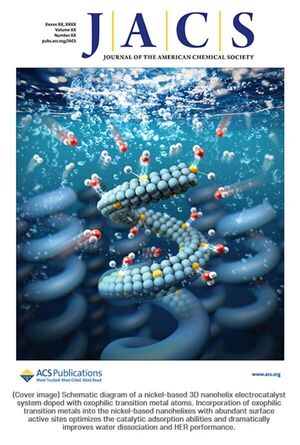
Making Hydrogen Energy with the Common Nickel
"To resolve the energy crisis and environmental issues, research to move away from fossil fuels and convert to eco-friendly and sustainable hydrogen energy is well underway around the world. Recently, a team of researchers at POSTECH has proposed a way to efficiently produce hydrogen fuel via water-electrolysis using inexpensive and readily available nickel as an electrocatalyst, greenlighting the era of hydrogen economy. A POSTECH research team led by Professor Jong Kyu Kim and Ph.D. candidate Jaerim Kim of the Department of Materials Science and Engineering and a team led by Professor Jeong Woo Han and Ph.D. candidate Hyeonjung Jung of the Department of Chemical Engineering have jointly developed a highly efficient nickel-based catalyst system doped with oxophilic transition metal atoms and have identified the correlation between catalytic adsorption properties and hydrogen evolution reaction (HER) kinetics in alkaline medium. Recognized for their significance, these research findings were featured as the front cover paper for the Journal of the American Chemical Society. Fuel cell is an eco-friendly power generating device that produces electricity using a chemical reaction in which oxygen (O₂) and hydrogen (H₂) produce water (H₂O). During this process, water electrolysis reduction occurs as a counter-reaction, which dissociates water to generate hydrogen fuel." [...]

Error protected quantum bits entangled
"For the first time, physicists from the University of Innsbruck have entangled two quantum bits distributed over several quantum objects and successfully transmitted their quantum properties. This marks an important milestone in the development of fault-tolerant quantum computers. The researchers published their report in Nature. Even computers can miscalculate. Already small disturbances change stored information and corrupt results. That is why computers use methods to continuously correct such errors." [...]

Studying Chaos with One of the World's Fastest Cameras
"There are things in life that can be predicted reasonably well. The tides rise and fall. The moon waxes and wanes. A billiard ball bounces around a table according to orderly geometry. And then there are things that defy easy prediction: The hurricane that changes direction without warning. The splashing of water in a fountain." [...]
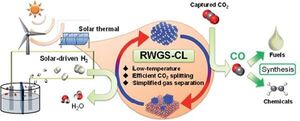
Copper-Indium Oxide: A Faster and Cooler Way to Reduce Our Carbon Footprint
"Scientists set a record for the highest conversion rate of carbon dioxide at low temperatures with copper-modified indium oxide, signifying sustainable e-fuel With ever-worsening climate change, there is a growing need for technologies that can capture and use up the atmospheric CO2 (carbon dioxide) and reduce our carbon footprint. Within the realm of renewable energy, CO2-based e-fuels have emerged as a promising technology that attempts to convert atmospheric CO2 into clean fuels. The process involves production of synthetic gas or syngas (a mixture of hydrogen and carbon monoxide (CO)). With the help of the reverse water-gas shift (RWGS) reaction, CO2 is broken down into the CO necessary for syngas. While promising in its conversion efficiency, the RWGS reaction requires incredibly high temperatures (>700°C) to proceed, while also generating unwanted byproducts. To tackle these problems, scientists developed a modified chemical-looping version of the RWGS reaction that converts CO2 to CO in a two-step method." [...]

How to Keep Drones Flying When a Motor Fails
"Robotics researchers at the University of Zurich show how onboard cameras can be used to keep damaged quadcopters in the air and flying stably – even without GPS. As anxious passengers are often reassured, commercial aircrafts can easily continue to fly even if one of the engines stops working. But for drones with four propellers – also known as quadcopters – the failure of one motor is a bigger problem. With only three rotors working, the drone loses stability and inevitably crashes unless an emergency control strategy sets in. Researchers at the University of Zurich and the Delft University of Technology have now found a solution to this problem: They show that information from onboard cameras can be used to stabilize the drone and keep it flying autonomously after one rotor suddenly gives out. Spinning like a ballerina “When one rotor fails, the drone begins to spin on itself like a ballerina,” explains Davide Scaramuzza, head of the Robotics and Perception Group at UZH and of the Rescue Robotics grand challenge at NCCR Robotics, which funded the research." [...]
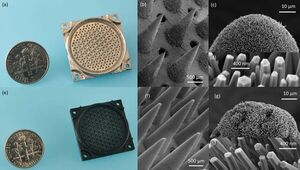
Nanosatellite thruster emits pure ions
"Study is first demonstration of a fully 3D-printed thruster using pure ion emission for propulsion. A 3D-printed thruster that emits a stream of pure ions could be a low-cost, extremely efficient propulsion source for miniature satellites. The nanosatellite thruster created by MIT researchers is the first of its kind to be entirely additively manufactured, using a combination of 3D printing and hydrothermal growth of zinc oxide nanowires. It is also the first thruster of this type to produce pure ions from the ionic liquids used to generate propulsion. The pure ions make the thruster more efficient than similar state-of-the-art devices, giving it more thrust per unit flow of propellant, says Luis Fernando Velásquez-García, principal research scientist at MIT’s Microsystems Technology Laboratories (MTL). The thrust provided by the device, which is about the size of a dime, is minuscule." [...]

A 1-Atom-Deep Look at a Water-Splitting Catalyst
"X-ray experiments at the U.S. Department of Energy’s Lawrence Berkeley National Laboratory (Berkeley Lab) revealed an unexpected transformation in a single atomic layer of a material that contributed to a doubling in the speed of a chemical reaction – the splitting of water into hydrogen and oxygen gases. This process is a first step in producing hydrogen fuel for applications such as electric vehicles powered by hydrogen fuel cells. The research team, led by scientists at SLAC National Accelerator Laboratory, performed a unique X-ray technique and related analyses, pioneered at Berkeley Lab’s Advanced Light Source (ALS), to home in on the changes at the surface layer of the material. The ALS produces X-rays and other forms of intense light to carry out simultaneous experiments at dozens of beamlines. “There is simply no other place in the world that can do these analyses on the level that the ALS can right now,” said Slavomír Nemšák, a beamline scientist at the ALS who contributed to the study, published Jan. 11 in Nature Materials. The technique they used allowed them to probe the surface of a catalyst material called lanthanum nickel oxide (LNO) that is useful in water splitting." [...]
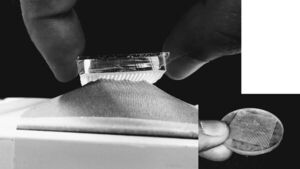
Fastener with Microscopic Mushroom Design Holds Promise
"A Velcro-like fastener with a microscopic design that looks like tiny mushrooms could mean advances for everyday consumers and scientific fields like robotics. In Biointerphases, published by AIP Publishing, researchers from Wageningen University in the Netherlands show how the design can use softer materials and still be strong enough to work. Probabilistic fasteners work, because they are designed with a tiny pattern on one surface that interlocks with features on the other surface. Currently available fasteners, like Velcro and 3M, are called hook and loop fasteners. That design requires harder, stiff material, which is what causes the loud ripping sound when they are peeled off and why they can damage delicate surfaces, such as fabrics, when attached to them. The team believes a 3D mushroom design can be made with softer, more flexible materials." [...]
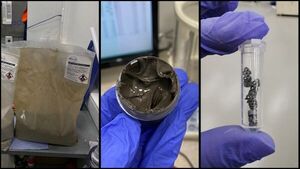
3D printing to pave the way for Moon colonization
"A research team from the Skoltech Center for Design, Manufacturing and Materials (CDMM) comprising 2nd year PhD student Maxim Isachenkov, Senior Research Scientist Svyatoslav Chugunov, Professor Iskander Akhatov, and Professor Igor Shishkovsky has prepared an extensive review on the use of Additive Manufacturing (AM) technologies (also known as 3D-printing) in crewed lunar exploration. Their paper published in the journal Acta Astronautica contains a comprehensive description of the geological composition of the lunar surface and the properties of lunar soil (lunar regolith) and its simulants, detailing their mineralogy, morphology, and chemical composition, in the light of their future use as feedstock for 3D-printing on the Moon surface. The authors evaluated different 3D-printing techniques presented in literature in terms of their suitability for in-situ manufacturing and maintainability, with focus on the adaptation of AM methods to low gravity, limited energy consumption, dimension and weight constraints of AM components delivered to the Moon, scalability of AM technologies, low-gravity performance of 3D-printing methods, and autonomy of AM applications. According to Maxim Isachenkov, “3D-printing technologies will be one of the cornerstones of lunar exploration, providing future astronauts with a required infrastructure, spare parts, and tools via local resources utilization.” He believes that, “There is no universal 3D-printing approach capable of dealing with all these tasks. Each approach will have a niche of its own, depending on multiple factors. It would be worthwhile to develop a strategy on how to use a set of AM methods individually or in combination and select a technique best suited for a specific purpose.” The team hopes that their review will help researchers across the globe to find the most promising AM techniques for further research and development and involve more teams in these studies, which could eventually contribute to the sustainable development of the future lunar infrastructure and the expansion of human presence in space." [...]

Researchers develop new graphene nanochannel water filters
"Brown University researchers have shown that tiny channels between graphene sheets can be aligned in a way that makes them ideal for water filtration. When sheets of two-dimensional nanomaterials like graphene are stacked on top of each other, tiny gaps form between the sheets that have a wide variety of potential uses. In research published in the journal Nature Communications, a team of Brown University researchers has found a way to orient those gaps, called nanochannels, in a way that makes them more useful for filtering water and other liquids of nanoscale contaminants. “In the last decade, a whole field has sprung up to study these spaces that form between 2-D nanomaterials,” said Robert Hurt, a professor in Brown’s School of Engineering and coauthor of the research. “You can grow things in there, you can store things in there, and there’s this emerging field of nanofluidics where you’re using those channels to filter out some molecules while letting others go through.” There’s a problem, however, with using these nanochannels for filtration, and it has to do with the way those channels are oriented. Like a notebook made from stacked sheets of paper, graphene stacks are thin in the vertical direction compared to their horizontal length and width." [...]
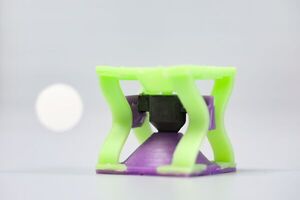
New metamaterial offers reprogrammable properties
"EPFL scientists have developed a metamaterial whose mechanical properties can be reprogrammed on demand and whose internal structure can be modified by applying a magnetic field. Over the past 20 years, scientists have been developing metamaterials, or materials that don’t occur naturally and whose mechanical properties result from their designed structure rather than their chemical composition. They allow researchers to create materials with specific properties and shapes. Metamaterials are still not widely used in everyday objects, but that could soon change. Tian Chen, a post-doc at two EPFL labs – the Flexible Structures Laboratory, headed by Pedro Reis, and the Geometric Computing Laboratory, headed by Mark Pauly – has taken metamaterials one step further, developing one whose mechanical properties can be reprogrammed after the material has been made. His research appears in Nature." [...]

Storing information with light
"New photo-ferroelectric materials allow to store information in a non-volatile way using light stimulus. The idea is to create energy efficient memory devices with high performance and versatility to face the challenges of the current society. The study has been publishd in Nature Communications by Josep Fontcuberta and co-workers and opens a path towards further investigations on this phenomenon and to neuromorphic computing applications. Can you imagine controlling the properties of a material by just shining light on it? We are used to see that the temperature of materials increases when exposed to the sun. But light may also have subtler effects." [...]

Inexpensive battery charges rapidly for electric vehicles, reduces range anxiety
"Range anxiety, the fear of running out of power before being able to recharge an electric vehicle, may be a thing of the past, according to a team of Penn State engineers who are looking at lithium iron phosphate batteries that have a range of 250 miles with the ability to charge in 10 minutes. "We developed a pretty clever battery for mass-market electric vehicles with cost parity with combustion engine vehicles," said Chao-Yang Wang, William E. Diefenderfer Chair of mechanical engineering, professor of chemical engineering and professor of materials science and engineering, and director of the Electrochemical Engine Center at Penn State. "There is no more range anxiety and this battery is affordable." The researchers also say that the battery should be good for 2 million miles in its lifetime. They report today (Jan. 18) in Nature Energy that the key to long-life and rapid recharging is the battery's ability to quickly heat up to 140 degrees Fahrenheit, for charge and discharge, and then cool down when the battery is not working. "The very fast charge allows us to downsize the battery without incurring range anxiety," said Wang." [...]

Constructing termite turrets without a blueprint
"Following a series of studies on termite mound physiology and morphogenesis over the past decade, researchers at the Harvard John A. Paulson School of Engineering and Applied Sciences have now developed a mathematical model to help explain how termites construct their intricate mounds. The research is published in the Proceedings of the National Academy of Sciences. “Termite mounds are amongst the greatest examples of animal architecture on our planet,” said L. Mahadevan, the Lola England de Valpine Professor of Applied Mathematics, of Organismic and Evolutionary Biology, and of Physics and lead author of the study. “What are they for? How do they work? How are they built?" [...]

Buildings – The unbreakable bond
"Researchers at Oak Ridge National Laboratory developed self-healing elastomers that demonstrated unprecedented adhesion strength and the ability to adhere to many surfaces, which could broaden their potential use in industrial applications. Elastomers, commonly used in the construction industry as sealants, are known for their durability. However, they can develop cracks when exposed to certain environments, leading to air and water leaks. In a study, ORNL researchers used a blend of a self-healing polymer with curable elastomers to produce a series of self-healable and highly adhesive materials. The team proved that these elastomers can self-repair in ambient temperatures and conditions, as well as underwater, with their adhesive force only minimally impacted by surface dust. “These tough elastomers can be made simply and efficiently through a scalable process, enabling a wider range of uses for the building, automotive and electronics industries,” ORNL’s Diana Hun said." [...]

Solar activity reconstructed over a millennium
"An international team of researchers led by ETH Zurich has reconstructed solar activity back to the year 969 using measurements of radioactive carbon in tree rings. Those results help scientists to better understand the dynamics of the sun and allow more precise dating of organic materials using the C14 method. What goes on in the sun can only be observed indirectly. Sunspots, for instance, reveal the degree of solar activity – the more sunspots are visible on the surface of the sun, the more active is our central star deep inside. Even though sunspots have been known since antiquity, they have only been documented in detail since the invention of the telescope around 400 years ago. Thanks to that, we now know that the number of spots varies in regular eleven-year cycles and that, moreover, there are long-lasting periods of strong and weak solar activity, which is also reflected in the climate on Earth." [...]

Colgate Planetary Geologist Publishes Groundbreaking Analysis of Mysterious Martian Glaciers
"In a new paper published today in the Proceedings of the National Academies of Science (PNAS), planetary geologist Joe Levy, assistant professor of geology, reveals a groundbreaking new analysis of the mysterious glaciers of Mars. On Earth, glaciers covered wide swaths of the planet during the last Ice Age, which reached its peak about 20,000 years ago, before receding to the poles and leaving behind the rocks they pushed behind. On Mars, however, the glaciers never left, remaining frozen on the Red Planet’s cold surface for more than 300 million years, covered in debris. “All the rocks and sand carried on that ice have remained on the surface,” says Levy. “It’s like putting the ice in a cooler under all those sediments.” Geologists, however, haven’t been able to tell whether all of those glaciers formed during one massive Martian Ice Age, or in multiple separate events over millions of years. Since ice ages result from a shift in the tilt of a planet’s axis (known as obliquity), answering that question could tell scientists how Mars’ orbit and climate have changed over time — as well as what kind of rocks, gases, or even microbes might be trapped inside the ice." [...]

Transforming quantum computing’s promise into practice
"Electrical engineer William Oliver develops technology to enable reliable quantum computing at scale. It was music that sparked William Oliver’s lifelong passion for computers. Growing up in the Finger Lakes region of New York, he was an avid keyboard player. “But I got into music school on voice,” says Oliver, “because it was a little bit easier.” But once in school, first at State University of New York at Fredonia then the University of Rochester, he hardly shied away from a challenge. “I was studying sound recording technology, which led me to digital signal processing,” explains Oliver. “And that led me to computers.” Twenty-five years later, he’s still stuck on them." [...]
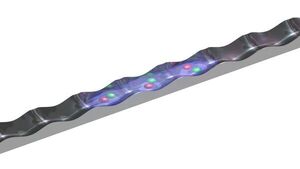
One dimensional quantum lattice liquids
"Liquids are ubiquitous in Nature: from the water that we consume daily to superfluid helium which is a quantum liquid appearing at temperatures as low as only a few degrees above the absolute zero. A common feature of these vastly different liquids is being self-bound in free space in the form of droplets. Understanding from a microscopic perspective how a liquid is formed by adding particles one by one is a significant challenge. Recently, a new type of quantum droplets has been experimentally observed in ultracold atomic systems. These ones are made of alkaline atoms which are cooled down to extremely low temperatures of the order of nanokelvins. The main peculiarity of these systems is that they are the most dilute liquids ever experimentally observed." [...]

Superconducting Microprocessors? Turns Out They're Ultra-Efficient
"The 2.5 GHz prototype uses 80 times less energy than its semiconductor counterpart, even accounting for cooling Computers use a staggering amount of energy today. According to one recent estimate, data centers alone consume two percent of the world’s electricity, a figure that’s expected to climb to eight percent by the end of the decade. To buck that trend, though, perhaps the microprocessor, at the center of the computer universe, could be streamlined in entirely new ways. One group of researchers in Japan have taken this idea to the limit, creating a superconducting microprocessor—one with zero electrical resistance. The new device, the first of its kind, is described in a study published last month in the IEEE Journal of Solid-State Circuits. Superconductor microprocessors could offer a potential solution for more energy efficient computing power—but for the fact that, at present, these designs require ultra-cold temperatures below 10 kelvin (or -263 degrees Celsius)." [...]

Designing customized “brains” for robots
"A new system devises hardware architectures to hasten robots’ response time. Contemporary robots can move quickly. “The motors are fast, and they’re powerful,” says Sabrina Neuman. Yet in complex situations, like interactions with people, robots often don’t move quickly. “The hang up is what’s going on in the robot’s head,” she adds. Perceiving stimuli and calculating a response takes a “boatload of computation,” which limits reaction time, says Neuman, who recently graduated with a PhD from the MIT Computer Science and Artificial Intelligence Laboratory (CSAIL)." [...]

Bringing Atoms to a Standstill: NIST Miniaturizes Laser Cooling
"It’s cool to be small. Scientists at the National Institute of Standards and Technology (NIST) have miniaturized the optical components required to cool atoms down to a few thousandths of a degree above absolute zero, the first step in employing them on microchips to drive a new generation of super-accurate atomic clocks, enable navigation without GPS, and simulate quantum systems. Cooling atoms is equivalent to slowing them down, which makes them a lot easier to study. At room temperature, atoms whiz through the air at nearly the speed of sound, some 343 meters per second. The rapid, randomly moving atoms have only fleeting interactions with other particles, and their motion can make it difficult to measure transitions between atomic energy levels. When atoms slow to a crawl — about 0.1 meters per second — researchers can measure the particles’ energy transitions and other quantum properties accurately enough to use as reference standards in a myriad of navigation and other devices." [...]
Documentação
A documentação é parte essencial do processo de aprendizagem e a Internet além de artigos interessantes de explorar também tem alguma documentação em formato PDF interessante de ler. Todos os links aqui apresentados são para conteúdo disponibilizado livremente pelo editor do livro.
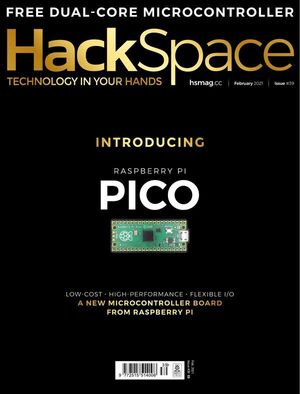
HackSpace magazine #39
"Introducing Raspberry Pi Pico, the brand new microcontroller from Raspberry Pi. It’s got two cores running at up to 130MHz, a flexible I/O system and it only costs $4 (plus local taxes and shipping). Take a look in HackSpace magazine 39 to find out what’s going on inside Pico and how to get the most our of this new microcontroller board. - Free Raspberry Pi Pico with every print magazine - Eben Upton talks about designing a new microcontroller - Get started with MicroPython on Pico - Parametric designs with FreeCAD" [...]
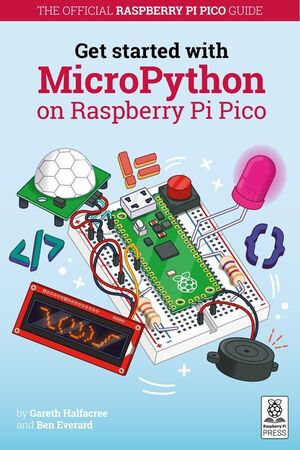
Get Started with MicroPython on Raspberry Pi Pico
"Raspberry Pi Pico is a new low-cost, high-performance microcontroller board with flexible digital interfaces. Microcontrollers are computers stripped back to their bare essentials. You don’t use monitors or keyboards, but program them to take their input from, and send their output to the input/output pins. Using these programmable connections, you can light lights, make noises, send text to screens, and much more. In Get Started with MicroPython on Raspberry Pi Pico, you will learn how to use the beginner-friendly language MicroPython to write programs and connect hardware to make your Raspberry Pi Pico interact with the world around it. Using these skills, you can create your own electro‑mechanical projects, whether for fun or to make your life easier." [...]
Projetos Maker
Diversos Projetos interessantes.

Magic MQTT Button for HomeKit (Homebridge)
"The purpose of this project is to use the low-cost ESP8266 module to create a "Magic Switch" that can integrate with various home automation solutions such as Node-red, Home Assistant, Apple HomeKit (using Homebridge), and many more. I decided to make use of MQTT as the messaging protocol for the Magic Switch because it is fast and reliable using custom firmware on the ESP8266 module known as Tasmota. The purpose of the switch is to trigger an Automation or Scene in a smart home instance. For this instructable you require a running instance of Homebridge and MQTT. Both these solutions can be easily installed on the low-cost Raspberry pi. A good guide on getting started with Homebridge on the Raspberry pi can be found at this wiki or on the official Homebridge website." [...]

Smart Home Automation Using Blynk & ESP32 IoT Projects | WiFi & Manual
"In this IoT project, I have shown how to make IoT based Smart Home Automation Using Blynk & ESP32 to control an 8-channel relay module from the manual switch & smartphone using the Blynk App. If the internet is not available, then you can control the home appliances from manual switches. During the article, I have shown all the steps to make this home automation system. This ESP32 control smart relay has the following features: 1. Control home appliances with WiFi (Blynk App) 2. Control home appliances with manual switches." [...]

DIY Arduino Robot Arm – Controlled by Hand Gestures
"Introducing MARK 1, the programmable Arduino Robot Arm. But, that's not all, this Robot Arm can be controlled by Hand Gestures. Here's How.. Introducing the DIY Robot Arm controlled by Human Gestures. Blockbuster Films like Pacific Rim, Avatar and other Sci-Fi Movies have hinted at the ability to synergize with Robots – where your movements can be enhanced with Robotic assistance. What if we could build the same industrial Robot, but on a smaller scale?" [...]
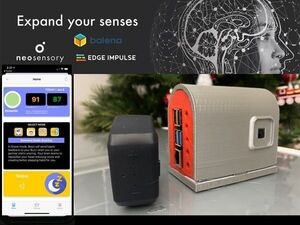
Boon - A sensory substitution for ASD, better sleep and more
"This device classifies human emotions, snores, sign languages, visual objects using EI and provide haptic feedback through Neosensory Buzz. When I first noticed Expand Your Senses challenge on Hackster, I told myself, this is a perfect marriage - sensory substitution with artificial intelligence! Well, what is sensory substitution? In simple words, it's a technique to supplement the lost of one sense by feeding it's information from another channel. For example, when a person goes blind, generally does not lose the ability to see, they simply lose their ability to transmit the sensory signals from the retina to brain. Since the vision processing pathways are still intact, a person who has lost the ability to retrieve data from the retina can still see subjective images by using data gathered from other sensory modalities such as touch or audio." [...]
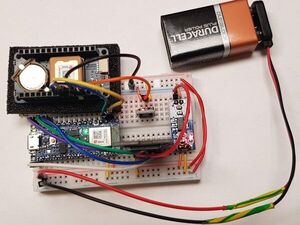
GPS and AHRS Data Logger
"Real-time position data and AHRS data logged to a mSD card. GPS and AHRS data logger on SD card. Connecting Arduino Nano 33 BLE Sense, MKR GPS Shield with ublox 8M GPS and mSD card adapter. Connect the datalogger to a 9V battery and a data file will be written to the mSD card. The 3 color LED on the Arduino shows the status of the logger: red: initializing, blue: initialized and waiting to find satellites, green: satellites find and logging data to the card. " [...]

Comfortable and Powerful Amplifier Circuit
"We Connect 2SC5200 Collector With 2SA1216 Base. Then We Connect 2SC5200 Emitter With 2SA1216 Collector. Then We Connect 100 K Ohm Resistor With 2SC5200 Base & 2SA1216 Emitter. Now Connect 0.47 Ohm Resistor With 2SA1216 Emitter. Now Connect 1000µf/16v Capacitor Positive Leg With 2SC5200 Base. It Is The Time To Connect Audio Input Cable." [...]
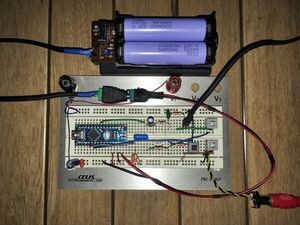
echoTrek - Digital Delay / Echo - Audio Effects with Arduino
"8Bit Digital Delay / LO-FI Bitcrusher / Reverse Speech DSP Pedal Effects for Guitar, Voice, Synths, etc. Story Tired of flashing LEDs and writing "Hello World" with Arduino? So let's go to something different ... Since I started using Arduino in my projects, I have always been curious to use it in audio applications, because despite its limitations it has analog-to-digital and digital-to-analog converters, which allow you to do many interesting things in the field of audio. During the end of last year I decided to put this into practice and wrote a code for the Arduino to be used as an effects module like Digital Delay, Echo, Bitcrusher LO-FI and Speech Reverse. So, here's the project." [...]
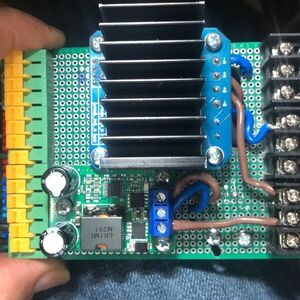
Fishbot
"Fishing robot controlled by bluetooth and automatically operating.to enable older and people with disabilities have the fishing fun. Fishing always fun for whomever tried first time, but you must be able to have basic motor skills such as holding a rot ,pulling the fish, hooking and unhooking the bait. Imagine you can only move your fingers or not able to hold the rot? There are many commercial products available on the market. None of them is fully accessible or a reel for just lazy people :) I took my father many times to fishing and ended up pulling the 5-10kg puffer fishes, jacks by myself. Where is the fun is you can not pull your own fish?" [...]
Glass Stone LED Tube (WiFi Controlled Through Smartphone App)
"Hello fellow makers! In this instructable I will show you how to build a WiFi-controlled LED tube which is filled with glass stones for a nice diffusion effect. The LEDs are individually addressable and therefore some nice effects are possible in the end. And the best: The firmware for the microcontroller comes with a super-easy to use smartphone app for Android and iOS devices! The following parts were used: Hardware Plexiglass Tube, 1m high, OD/ID 60mm/54mm WS2812B LED Strip, 60 LEDs/m (you need 4m in total) Wemos D1 Mini Microcontroller Broken Glass Decor Stones, 3-4kg (you can most likely get these also from your local gravel shop) Square Aluminum Profile, 10x10x1mm, 1m long (you can get this from your hardware shop) ~50cm of LED cables (min. 22 AWG, 3-pin) 5V power supply, minimum 6A DC Power Plug, 1x female + 1x male General purpose glue Equipment 3D printer (my favorite one) Soldering iron (my favorite one) Hot Glue Gun Software WLED (as firmware for the Wemos D1 Mini)" [...]

ESP32 & Cellular IoT CI Build Status Light
"Monitor your CI builds with the blues wireless Notecard and an ESP32 Feather! I've been a software engineer for over twenty years, and one of the things that has always fascinated me is testing. Unit testing, integration testing, TDD, BDD, automated testing, CI tools: all of it gives me the warm fuzzies. A solid testing approach gives an engineering team the confidence that a product works as it should, and a safety net to refactor and evolve a codebase without fear of breaking everything. When I joined blues wireless last year, one of the tasks I took on was maintenance of the open source libraries and SDKs in our GitHub organization. We have libraries for using the Notecard (our core hardware product) with Arduino, C/C++, Go, and my personal favorite language, Python." [...]

MONITORING RASPBERRY PIs
"A simple interface to monitor my raspberry pis (headless) and my laptop thanks to MQTT and Node Red Story Happy owner of a pihole based on a Raspberry Pi zero W and a Raspberry Pi 4 which is used as a server for several purposes (owncloud, MQTT broker, back up of my laptop...) I wanted to be able to easily monitor them with a webbased interface. So I chose to develop the following solution : Each board or laptop is running a python script which gather information such as cpu speed, core temperature, disk usage... and compact them into a json message send them to my MQTT Broker The Raspberry Pi 4 (which is also the MQTT Broker) uses this information through a node red flow to build a nice (in my opinion) dashboard. The overall project is quite simple and was especially a good way to discover json format, mqtt and basic node red usage. "Client" Side On the client side the code running is based on Python 3. It gathers the following values thanks to psutils lib : Name of the host Uptime Core Temperature Virtual Memory (%) Disque usage (%) Average load (1min, 5min, 15min) CPU Usage per core (%) The value are next packed into a json message and published to MQTT broker. To enable the.py script to run at boot, I had it to my cron tab (@reboot...)." [...]

Very DeepSleep and energy saving on ESP8266 – Part 6: Power DOWN/UP
"The easiest way to save power on an ESP8266 is in fact to switch it OFF when not needed and Switch it ON when needed. A typical example of that is a notifier that mail has been delivered or a door has been opened. Opening a mailbox or opening/closing a door activates a Switch that connects the Vcc to 3V3 and the ESP8266 boots up and does its thing. This seems ideal for the ESP8266-01 that does not have gpio16 broken out and therefore is hard to use in regular deep sleep. This concept will not work though if the switch prematurely is deactivated and the ESP8266 has not finished its job yet. You need some way to keep the ESP running til it’s job is finished and this means it needs to maintain power and thus the regular ‘deep sleep’ seems the only option." [...]

Lazy 7 / Quick Build Edition
"Yes. Another one. I'll copy/paste the infos I've put up on Thingiverse here, this documentation is only really needed for the led strip routing. Recently I published the 7 Segment Clock - Small Printers Edition, the first 7 segment display I built using led strips with 30 leds/m. One thing that wasn't really possible was using a single led strip for the whole clock, like Lazy 7 / One. But Lazy 7 / One does require lots of material and is not really something you're going to print within a few hours." [...]

ML-Based Bird and Squirrel Detector (Raspberry Pi and AWS)
"You can use ML tools from AWS and connect them to a Raspberry Pi to ID birds at your bird feeder. System Overview As shown in the diagram below, the Raspberry Pi sends pictures from my bird feeder to an S3 bucket at AWS. When a new image arrives in S3, this invokes a Python Lambda function that sends the photo to AWS Rekognition, which uses its ML-based image recognition capabilities to determine what's in the photo. If a bird is detected, this triggers a message to an SNS topic, which you can use to get a text or email. If a squirrel is detected, a message is sent to a different SNS topic. So you might use texts to notify yourself of a squirrel sighting so you can go chase it away, and use email to notify yourself about interesting birds." [...]

Digital Speedometer to Car's Instrument Cluster via CAN Bus
"Implementing my own Arduino CAN bus Shield and digital speedometer to car's LCD-display in instrument cluster. Start of the Project It all started in the summer of 2020, when I bought an Audi TT 2002. Unlike my previous cars, it didn’t have a digital speedometer in the instrument cluster’s little LCD-display (Driver Information System DIS in Audi). Due to the lack of digital speedometer, I decided to implement it myself. To cut a long story short, I thought I could take advantage of existing GitHub-project and wrote the code for that setup first. Though I soon realized the setup used in the existing project was different to mine, so I had to start it all over." [...]
Build a WIFI Connected Clock Using Meadow
"Build this nifty clock with Meadow getting the date and time from a public web API via WIFI and room temperature with an LM35 Analog sensor. In this Meadow project we'll learn how to build a clock that shows you the time and date on a LED Matrix using a public web service API, and room temperature with an LM35 analog temperature sensor. We will see how easy is to connect your Meadow board to your home wireless network with its onboard WIFI capabilities, and we'll use Meadow.Foundation to drive the peripherals and MicroGraphics to draw text and lines on the display. Meadow.Foundationa platform for quickly and easily building connected things using.NET on Meadow. Created by Wilderness Labs, it's completely open source and maintained by the Wilderness Labs community. If you're new working with Meadow, I suggest you go to the Getting Started w/ Meadow by Controlling the Onboard RGB LEDproject to properly set up your development environment." [...]

64-Key Prototyping Keyboard Matrix for Arduino
"A simple PCB keyboard that you can easily use for your Arduino project. Fully-customizable code provided! I am currently working on a project that will have an integrated keyboard, which presented a problem: how do I include a keyboard in the development board prototype? I can't use a USB keyboard or an existing Arduino-based keyboard, because the keyboard in the actual project is connected directly to the microcontroller that handles all of the other functions. So I designed this basic PCB-based 64-key prototyping keyboard matrix. This PCB does not contain any ICs (integrated circuits)." [...]

PasswordVault
"Make a Wio Terminal store all your passwords and have it type them for you into any services. With master key, encryption, and search. This sketch for the Seeed Wio Terminal (affiliate link) reads a list of encrypted passwords from a file "/crypted.txt" on the SD card and displays them on the screen of a Wio Terminal. Once you have unlocked the software by keying in your master passcode, you can select an entry from the list by filtering and browsing with the 5-way joystick of the Wio Terminal. A password entry is selected by pressing the 5-way joystick. The password is then typed to your computer by emulating a keyboard." [...]
Guitar Hero MIDI Controller
"You can turn an old Guitar Hero accessory into a USB MIDI controller for your synthesizer! Wii accessories use I2C to send all of their data, so we'll couple the Guitar Hero controller with a STEMMA QT Nunchuck Breakout and an Adafruit QT Py to read all the fret buttons, whammy bar, strum bar, and joystick data. You'll be able to send MIDI notes, chords, octave changes, whammy bar pitch bends, and joystick CC messages to any software synth or a USB MIDI host-capable synthesizer. " [...]

BLE & LoRa Based Indoor Location Tracker Without GPS
"GPS-based location tracking is one of the very important services nowadays. We use this to find a path to our destination and also track the position of our goods using this. But have you ever heard of location tracking without using GPS? Today we are going to discuss the idea of making a location tracker using BLE and LoRa Technology. We are not going to make one today but we will discuss how it would work. But before that, we are going to discuss what's inside the modules that can make this application possible." [...]
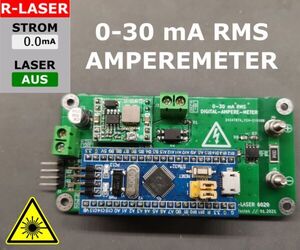
Digital RMS Amperemeter for Laser Cutters
"Hi, in this Instructable I want to show you, how you can build your own Digital RMS Amperemeter for your Laser Tube. While working with my Co2-Laser for a while now, I wanted to knew all the parameters about the Laser Tube. However the most common setup to measure the Current of the Lasertube is to use an analog Amperemeter like this one: It wasn't my favorite at all, so I have put it in my switch cabinet, but because the knowlegde of the current is so important I have startet to design my own Digital Amperemeter. Features of the Amperemeter: - TRUE RMS Measurement of the Current - 0-30 mA Range with a Resolution of 0.1 mA - TFT-Display - One Digital Input for safety control - 24 V Input Voltage - Cost: +-20€" [...]

ESP32 Remote Surveillance Robot
"The ESP32 robot cam is a mobile surveillance robot that can be controlled over the internet. It is built around a standard ESP32-Cam board, plus a motor driver, batteries, power supply board, and motorized platform. It also includes an optional inductive charger so that it can "dock" and recharge itself while remaining connected to the internet and ready to respond to commands without depleting its battery. Supplies: ESP32-Cam (AI-Thinker, or clone) AdaFruit PowerBoost 500 DRV883 Motor Driver LiPoly battery, such as this one. 4x AA batteries Half-size breadboard Robot chassis Variable potentiometer (optional, for reporting charging status on the web page) Inductive charger (optional) Male to male Dupont wires, or other breadboard wires Tools: FTDI board, such as this or this or this. Hot glue gun, or adhesive strips, or adhesive Velcro strips Soldering iron" [...]
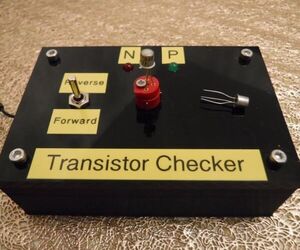
Simple Transistor Checker
"Transistors (derived from transfer resistance), are the basic building blocks of our technological world. You may have a box full of assorted transistors or you may have them segregated by type in individual labelled draws or boxes. In either case you may want to determine the type and/or whether it is functional or not. Unless, you have some type of dedicated component tester you may resort to using a DMM in diode or resistance mode unless a transistor test mode is provided. However, if you have a large number of assorted transistors, purchased as a mixed bag or had your carefully labelled boxes end up as an unintentional mixed bag using a DMM with basic functions can be a long process. Have only a DMM with basic functions than the following simple transistor checker will complement your tool set." [...]
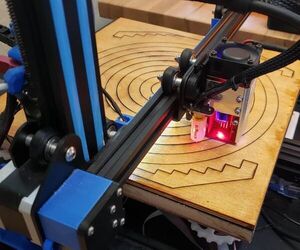
How to Add a Laser Engraver to Your 3D Printer
"I wanted to laser engrave a clock face for a magnetic clock I am building, but didn't want to invest in a laser engraver without knowing how much I would use it. Also the clock face is larger than most laser engravers allow. I have a CR-10 3D printer, which can be driven as a laser engraver, and has a 300x300mm workspace. I just needed to figure out how to mount and drive the laser on the CR-10. After some research, I discovered you can drive most diode laser engravers from the PWM output of the part cooling fan. However, you can't just use the fan wires already connecting the printer control board to the cooling fan." [...]
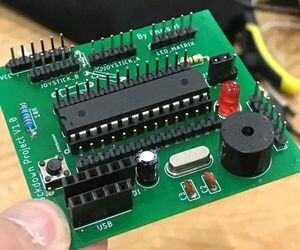
Arduino Pong Tennis PCB | Arduino, Autodesk Eagle and JLCPCB
"This Instructable follows on from my 'Pong Tennis With LED Matrix, Arduino and Joysticks' project where we completed the wiring for the project and wrote the code. It can be found here. Or by searching Instructables for "Pong Tennis With LED Matrix, Arduino and Joysticks". The project is intended for everyone from beginners up however this Instructable targets those who want to take the previous pong project to the next level and put it on a custom made PCB. To design the circuit board you first need to draw a schematic of your design on a piece of EDA (Electronic Design Automation) software, I'm using Autodesk Eagle as part of Fusion 360, a popular CAD software. I choose to use Autodesk Eagle as I was already familiar with other Autodesk software and was following the excellent Instructables Class on PCB design which can be found here." [...]

Automatic Rainbow Staircase Lighting
"I show you here how to create automatic and progressive lighting of stairs in the rainbow style! No more getting up at night using the light on your cell phone to avoid switching on! For this I used cable ducts where NeoPixel LEDs are installed. Detection is provided at the top and bottom by PIR presence detectors, installed in the 3D printed supports. The "intelligent" part is entrusted to an Arduino Nano. A light sensor enables the system to be activated only if it is dark enough, and 2 potentiometers allow adjustments, one for light sensitivity, and the other for the duration of ignition (0 to 5 minutes) Supplies: Material: 4 white solid wiring ducts 3x1 cm x 2 m (1.3 € x 4) 26 WS2812B addressable 5050 RGB NeoPixel LEDs (€ 14.23 for 100) 220V - 5V 3A power supply (€ 13.28) Arduino Nano 2 PIR sensors HC-SR501 (€ 9.59 for 5) Photoresistor 2 Potentiometers 10 Kohms 2 Resistors 470 ohms Capacitor 1000 µF" [...]
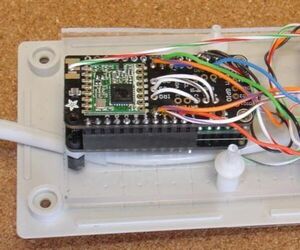
LoRa Controlled Garage Door
"This project replaces the WiFi Garage Door control base on an ESP2866 with a radio/LoRa version for greater range and includes a push button long range radio/LoRa remote for use from the car. Originally this project attempted to use an Adafruit Feather M0 LoRa board, however that board locked up repeatedly when mains powered. After trying a number of fixes, it was replaced with a Teensy 3.2 + Adafruit Teensy Adaptor + Adafruit Radio Feather Wing. The Teensy combination has proved to be completely reliable. The Adafruit Radio Feather Wing is an LoRa version but this project does not use the LoRa infrastructure. Instead a simple point-to-point connection, protected by 128 bit security, is used." [...]
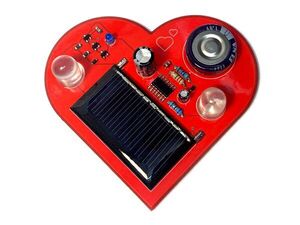
BEAM Solar Powered Pummer (Heart Shaped PCB)
"This is a project that I have been meaning to finish for over a year now. it is a heart shaped, BEAM based pummer circuit I made to charge up during the day and flash like a heart beating at night. The solar engine is a SIMD1 solar engine by Wilf Rigter and the pummer is a modified version of his power saver flasher which flashes 2 LEDs off the one oscillator. My final design lasts about 3 hours from when the sun starts to go down. I personally love creating PCBs as a step up from breadboard or perfboard circuits, and I especially like designing PCBs that go a little beyond just connecting components. Hopefully through this Instructable you will see that while a PCB designer such as Eagle can be superbly powerful, creating a functional and aesthetic circuit such as the one presented here can be quick, fun and really accessible." [...]
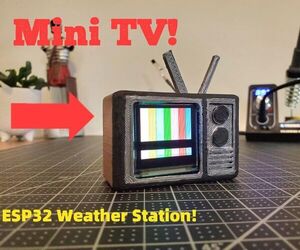
Mini-TV Weather Station With the ESP32!
"Hello everyone, today I'm going to show you how I built a Mini-TV weather station with the ESP32! This is a very fun project I made over Christmas break, that should be relatively easy for people of all skill levels. Here is the weather data that it will display: Current Temperature Minimum Temperature Maximum Temperature Atmospheric Pressure Humidity Wind Speed Let's get started! Supplies: Here are the parts as well as the links to buy them: 128x128 RGB OLED Here ESP32 Dev Module Here Brown, Black, and Grey paint Here Li-Po Here Charging Circuit Here 3.3v to 5v converter Here Slide switch Here Wire Here Push Button Here Multimeter Here Lead free Solder Here Soldering Iron Kit Here (don't use solder in kit)" [...]

Adrianino. ATtiny 1614. UPDI.
"The following project was born with the idea that electronics is very easy to learn and modular at the same time. Although I have already finished my Fab Academy, I am still researching. Speaking with my instructors Nuria and Pablo, I told them that I wanted to continue working on the Hello World project, but I was not satisfied with making a board for each sensor or actuator. So I decided to make a board with the ATtiny1614, where I could use the maximum pins for the inputs or outputs; that had external power; I2C connection. The idea is that a student can test as many sensors as possible, become familiar with electronics and programming little by little. And the Adrianino was born." [...]
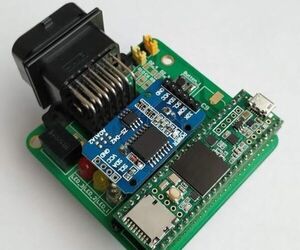
Datalogger System for Formula Student
"Background: Formula Student the world most established educational engineering competition which uses motorsport to inspire students. Backed by industry and high-profile engineers such as Patron, Ross Brawn OBE, the competition aims to develop enterprising and innovative young engineers and encourage more young people to take up a career in engineering. The format provides an ideal opportunity for students to demonstrate their engineering knowledge and test and improve their capabilities to deliver a complex and integrated product in the demanding environment of a motorsport competition. Objective: The main function of the datalogger module is to read two CAN communication BUS and record the information present on the BUS on an SD card at a rate of 200Hz, to later analyze the information regarding the vehicle's operation. In the module developed as it is to be integrated in a vehicle to compete in the formula student event, it has incorporated other features such as: - 2 digital and 4 analog inputs with respective signal conditioning; - 4 status smd leds; - A 5V Series and 3.3V communication bus; - Lap trigger; - RTC to know exactly when the data is being recorded, - A circuit capable of detecting a power failure in the module's power supply and ordering the closing of the SD card beforehand for not to lose the data acquired. The whole system was designed with the aim of being as compact as possible." [...]
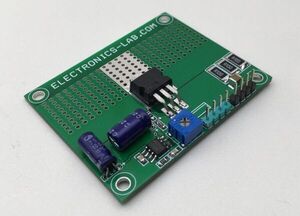
LED Fading Effect / LED Strobe using 555
"In general, generating an LED fade effect requires a microcontroller or another expensive circuit. We have built this low-cost LED fading board using an inexpensive 555 Timer. The 555 timer is used as an astable multivibrator, which generates low-frequency pulses, further, this pulse train is feed to the base of BJT transistor TIP122 with a series resistor along with a high-value electrolytic capacitor. The combination of resistor R5 and capacitor C6 at the base of Q1 gradually increases and decreases the base voltage which provides soft ON/OFF (Ramp) to the load. The circuit can drive a load up to 18W without heatsink. An onboard potentiometer is provided to adjust the frequency of flash." [...]

DIY Digital Clock Using ATmega328p, RTC DS3231 and Seven Segment Displays
"Introduction: This is an user friendly tiny digital table clock where user can access all basic functions of clocks including setting alarms, viewing temperature, viewing date, setting date and time, etc. It has a buzzer for alarm and four push buttons (Menu, Left, Right, Cancel) for user interaction. It can be powered by a standard micro USB cable. Its user interface is very simple. User can enter menu and then change the clock parameters (time, date, month, year, alarm, etc). The alarm parameters are stored in EEPROM of ATmega 328p so it dosen't forget alarm even if the power cuts." [...]
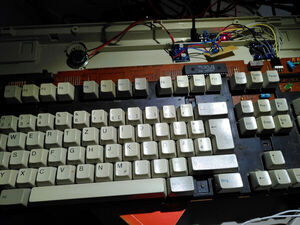
Talking keyboard
"Functional description The whole project is built around stuff I had laying around, so there should be plenty of ways pulling it off. An old keyboard (about 1988 vintage) gives the project its enclosure and "user-interface". An Arduino Nano is hooked up to the keyboards original controller and simulates the host PC and receives the keyboard inputs from the keyboard. The Arduino reads a WAV file from a FAT formatted SD card. The file name is determined by the key which was pressed so changing the sounds on the keyboard is as easy as properly naming WAV files on an SD card. The sound is output as PWM for the next stages." [...]
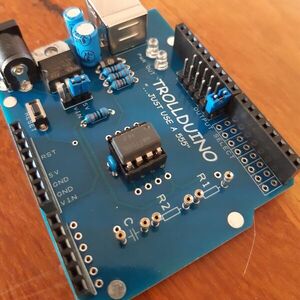
Trollduino V1.0
"Response to Hackaday comments section: a 555 timer in Arduino form factor "That's stupid! Why use an Arduino when you could do the same thing with a 555?" - representitive comment on any Hackaday post that describes any Arduino project ever. Well, here you go then. Enjoy. Ok, so now is your chance to put up or shut up." [...]
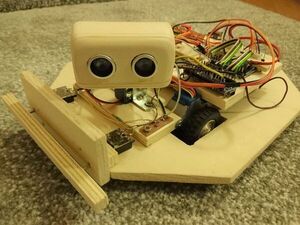
MyTurtle: self-learning robot (Part 3 - Head and Bumpers)
"This project is about creating a self-learning robot. Part 3 is about adding a head and bumpers to the movement unit. In the previous part (Part 2 - Movement unit) I wrote about making a chassis for the movement unit of the self-learning robot MyTurtle. In this part I am going to add checking obstacles with the ultrasonic sensor HC-SR04, bumpers to record a hit and show all the actual code to serve the movement unit. This project has a longer code so I created more tabs in the software to make things clear and easily accessible. Parts of the code lower are from these tabs." [...]
That's all Folks!



